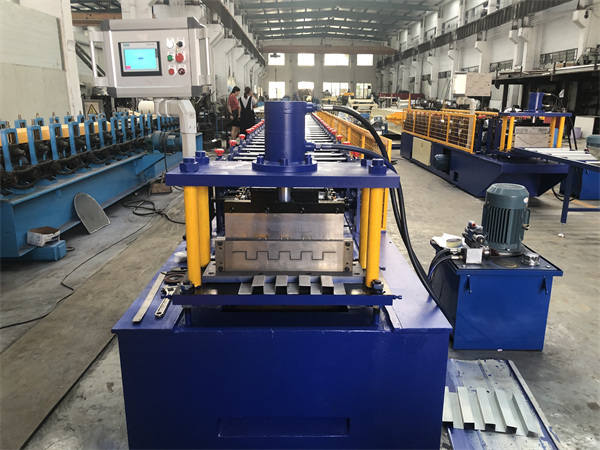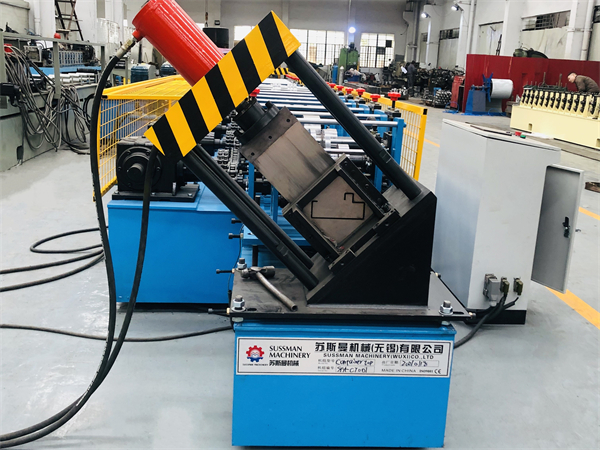1. Introduction
Ceiling T-Bar roll forming machines have revolutionized the construction industry by streamlining the production of suspended ceiling systems. These machines are designed to efficiently manufacture T-shaped metal bars used in drop ceilings. In this article, we’ll delve into the world of ceiling T-Bar roll forming machines, exploring their benefits, operational processes, maintenance, and more.
2. Understanding Ceiling T-Bar Roll Forming Machines
Ceiling T-Bar roll forming machines are automated systems specifically engineered to shape metal coils into T-Bar profiles. These profiles are essential components of suspended ceilings, providing structural support and aesthetic appeal. The roll forming process involves feeding a metal coil into the machine, which then passes through a series of rollers, gradually forming the desired T-Bar shape.

3. Benefits of Using Ceiling T-Bar Roll Forming Machines
The utilization of ceiling T-Bar roll forming machines offers several advantages to construction companies and manufacturers:
1. Efficiency and Speed
Traditional methods of fabricating T-Bar profiles are time-consuming and labor-intensive. Roll forming machines automate the process, significantly increasing production speed and overall efficiency.
2. Accuracy and Consistency
Roll forming ensures precise and consistent dimensions for each T-Bar produced, reducing material wastage and ensuring high-quality end products.
3. Customization
Modern roll forming machines allow for easy adjustments, enabling the production of various T-Bar profiles to meet specific project requirements.
4. Cost Savings
While the initial investment in a roll forming machine may seem significant, the long-term cost savings from reduced labor and material waste make it a financially sound decision.
4. Types of Ceiling T-Bar Profiles
Ceiling T-Bar roll forming machines can create different profiles to suit various architectural designs:
1. Main Tee
The primary supporting T-Bar that runs perpendicular to the ceiling joists.
2. Cross Tee
Shorter T-Bars that interlock with the main tee, forming the grid system for ceiling panels.
3. Wall Angle
L-shaped profiles used along the perimeter of the ceiling to provide a finished edge.
5. Factors to Consider When Choosing a Ceiling T-Bar Roll Forming Machine
Selecting the right roll forming machine is crucial for optimal results:
1. Material Compatibility
Ensure the machine can handle the metal type and thickness you plan to use.
2. Production Capacity
Consider the required production volume to choose a machine with the appropriate speed and capacity.
3. Customization Abilities
Opt for a machine that allows quick and easy profile adjustments to meet project specifications.

6. Steps in the Ceiling T-Bar Roll Forming Process
The roll forming process involves several steps:
1. Material Unwinding
The metal coil is unwound and fed into the roll forming machine.
2. Roll Forming
The metal passes through a series of rollers that gradually shape it into the desired T-Bar profile.
3. Cutting
The continuous profile is cut into individual T-Bars of the required length.
4. Punching and Notching
Holes and notches are punched or notched into the T-Bars to facilitate easy assembly.
5. Stacking and Packaging
Finished T-Bars are stacked and packaged for transportation and installation.
7. Maintenance and Care of Ceiling T-Bar Roll Forming Machines
1. Regular Cleaning:
- Keep the machine clean from dust, debris, and metal shavings that can accumulate during the production process. Regularly clean the rollers, guides, and other components to prevent buildup that can affect the machine’s performance.
2. Lubrication:
- Proper lubrication of moving parts is essential to reduce friction and wear. Refer to the machine’s manual for recommended lubrication points and intervals. Use appropriate lubricants to avoid damaging the machine.
3. Inspection:
- Conduct routine inspections of the machine’s components, including rollers, guides, motors, belts, and chains. Look for signs of wear, damage, or misalignment. Address any issues promptly to prevent further damage.
4. Alignment:
- Ensure that the machine’s rollers and guides are properly aligned. Misalignment can lead to uneven production and premature wear of components. Adjust and align components as needed.
5. Tension Adjustment:
- Check and adjust the tension of belts, chains, and other moving parts. Proper tension ensures consistent operation and prevents slippage or breakage.
6. Replace Worn Parts:
- Identify and replace worn or damaged parts promptly. This includes rollers, blades, cutting tools, and any other components that show signs of wear. Using worn parts can result in subpar product quality and potential safety hazards.
7. Electrical Components:
- Inspect electrical components, such as wiring, switches, and sensors, for any signs of damage or malfunction. Ensure proper grounding to prevent electrical hazards.
8. Safety Measures:
- Always follow safety protocols when performing maintenance. Disconnect the machine from power sources before working on it. Use appropriate personal protective equipment (PPE) to prevent accidents.
9. Training and Education:
- Train operators and maintenance staff on the proper use and maintenance of the machine. Knowledgeable operators can identify issues early and perform routine maintenance effectively.
10. Record Keeping:
- Maintain a maintenance log that records all maintenance activities, repairs, and inspections. This log can help track the machine’s performance over time and identify patterns of issues.
11. Professional Servicing:
- Schedule regular professional servicing and maintenance by experienced technicians. They can perform in-depth inspections, diagnose complex issues, and provide recommendations for optimal machine performance.
12. Environmental Conditions:
- Ensure that the machine is placed in an environment with appropriate temperature and humidity levels. Extreme conditions can affect the machine’s performance and longevity.
8. Common Issues and Troubleshooting
Despite their efficiency, roll forming machines can encounter issues:
1. Material Jamming
Metal coils can sometimes jam in the machine. Clearing the jam and inspecting the feeding mechanism can resolve this.
2. Uneven Roll Forming
Inconsistent profiles may result from misaligned rollers. Adjusting and aligning the rollers can correct this problem.
9. Future Trends in Ceiling T-Bar Roll Forming Technology
The roll forming industry continues to evolve:
1. Advanced Automation
More sophisticated automation features will enhance production speed and accuracy.
2. Integration with CAD Software
Machines integrated with computer-aided design (CAD) software will enable real-time profile customization.

10. Conclusion
Ceiling T-Bar roll forming machines have transformed the construction landscape by streamlining the production of suspended ceiling components. Their efficiency, accuracy, and customization capabilities make them invaluable tools for modern construction projects. As technology continues to advance, we can expect even more innovative features in the world of roll forming.
11. FAQs
Are T-Bar profiles suitable for all types of ceilings?
T-Bar profiles are commonly used in commercial and residential suspended ceilings.
Can roll forming machines create T-Bar profiles of varying lengths?
Yes, roll forming machines can produce T-Bar profiles of different lengths to accommodate diverse ceiling dimensions.
What materials are typically used for T-Bar profiles?
T-Bar profiles are often made from galvanized steel or aluminum.
How long does it take to set up a roll forming machine for a new profile?
With modern quick-change systems, setup can take as little as 30 minutes.
Are roll forming machines eco-friendly?
Yes, roll forming machines contribute to eco-friendliness by reducing material waste and energy consumption compared to traditional methods.
